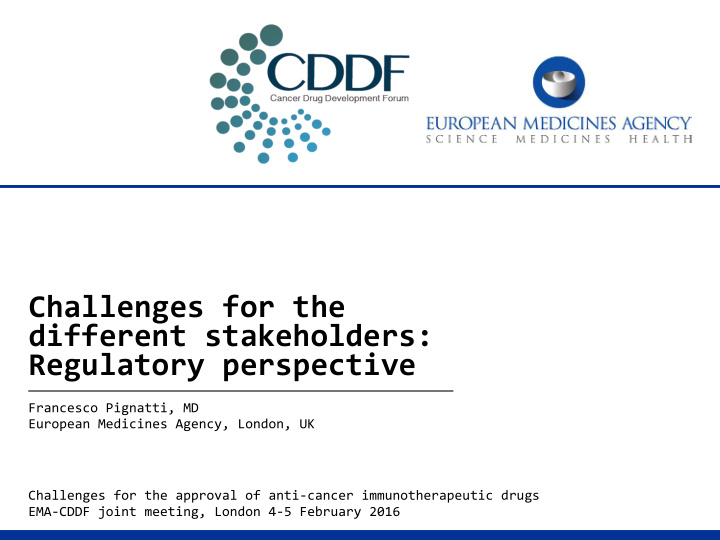



Challenges for the different stakeholders: Regulatory perspective Francesco Pignatti, MD European Medicines Agency, London, UK Challenges for the approval of anti-cancer immunotherapeutic drugs EMA-CDDF joint meeting, London 4-5 February 2016
Disclaimer The views expressed in this presentation are the personal views of the presenter and may not be understood or quoted as being made on behalf of or reflecting the position of the European Medicines Agency or one of its committees or working parties. Acknowledgments: J. Martinalbo (EMA); R. Giuliani (AO San Camillo-Forlanini); S. Tejpar (KU Leuven), J. Bogaerts (EORTC) 1
Objectives of scientific review of drug applications • Regulatory decision looks at single product Aims to establish if benefits > risks 1 Generally, randomized active and placebo-controlled trials 1 • If benefits outweigh the risks, approval is granted • Criteria for immunotherapy no different than other therapies → uncertainties? 1 Regulation (EC) No. 726/ 2004 2
Challenges • Uncertainties • Heterogeneity in treatment effect, markers • What evidence? Exploratory v. confirmatory data • Relative efficacy/ safety; how to compare PFS for different types of agents? • How to reflect uncertainties in product information? • Impact/ information for the Health-Technology Assessment? • Rapidly evolving therapeutic context • Risk perception, acceptance of uncertainty changes as new drugs get approved – regulatory mechanisms 3
Identifying hyper-, hypo- or non-responders • Understanding treatment effect • May provide clues that can be used to move us closer to personalized medicine • Help minimize the exposure to potentially toxic (and costly) treatments of those patients who are likely to be the least responsive • Exploratory subgroup analyses: Multiplicity v. heterogeneity biological plausibility, replication, and strength of evidence 4
Ipilimumab (melanoma) Optimal dose 3 or 10 mg/kg? Active brain metastases, ocular melanoma? Safety in patients with a history of autoimmune disease Extract from ipilimumab label: • Efficacy uncertain in women >50 years of age 5
Nivolumab (melanoma) Stratification by PD- L1 status (≥ 5%). Post-approval: • Further analyses to ascertain the potential role of the PD-L2 biomarker, to further explore the relationship between PD-L1 and PD-L2 expression on the efficacy of nivolumab • To explore optimal cut-off for PD-L1 positivity and to • Investigate the possible change in PD-L1 status of the tumour during treatment and/or tumour progression 6
Estimating optimal cut-offs How to parametrise factor (binary, categorical, continuous…)? What functional form of interaction (linear, non-linear)? Visual exploration or formal estimation of optimal cut-offs Dynamic marker expression and intra-tumour heterogeneity Different assays Hansen & Siu, JAMA Oncol 2016 7
Considerations on biomarker development Tension between different objectives: Early access to market Maximising benefits & efficiency Reaching widest possible Develop biomarkers for patient patient population selection Co-develop one-drug/one- Develop general assays to inform assay/one-histology treatment decisions across drugs and histologies Use study material for Share material and data to identify further development biomarkers, compare assays, explore mechanism of resistance etc. • Do we need a new framework for biomarker development? A role for independent academic/regulatory platforms? 8
Treatment beyond PD Effective immune response may need more time to develop • How to monitor response? Need standard criteria 1 • Tumour biopsies taken before and after treatment? • How to compare PFS against cytotoxic compounds? OS recommended (but what if multiple line of treatments?) 1 RECIST Working Group to investigate whether there is a role for RECIST in the evaluation of immunotherapeutic agents 9
Product information • How to reflect uncertainties in product information? E.g., linear association between (continuous) biomarker expression and efficacy • Impact on shared decision-making? • Restrict using an arbitrary cut-point? • May be perceived as unfair if just missed cut-off; encourage off- label use.) • Broad indication (“Let patients-clinicians decide”) • Warn about extremes? Just show the data? • Confidence in shared decision-making? Better understanding of patient preferences? • What information to facilitate the Health- Technology Assessment? 10
Post-approval challenges 11 Martinalbo et al. Ann Oncol 27: 96–105, 2016
Summary • Numerous (new) uncertainties pose challenges Validation of predictive biomarkers; better understanding of functional relationship and estimating optimal cut-offs How to reflect uncertainties in product information? • Need to evolve from the one-drug/one- histology/one-diagnostic assay or develop framework for comparative research • Is the current (post-marketing) framework for biomarker development adequate? A role for independent academic/regulatory platforms? 12
Recommend
More recommend